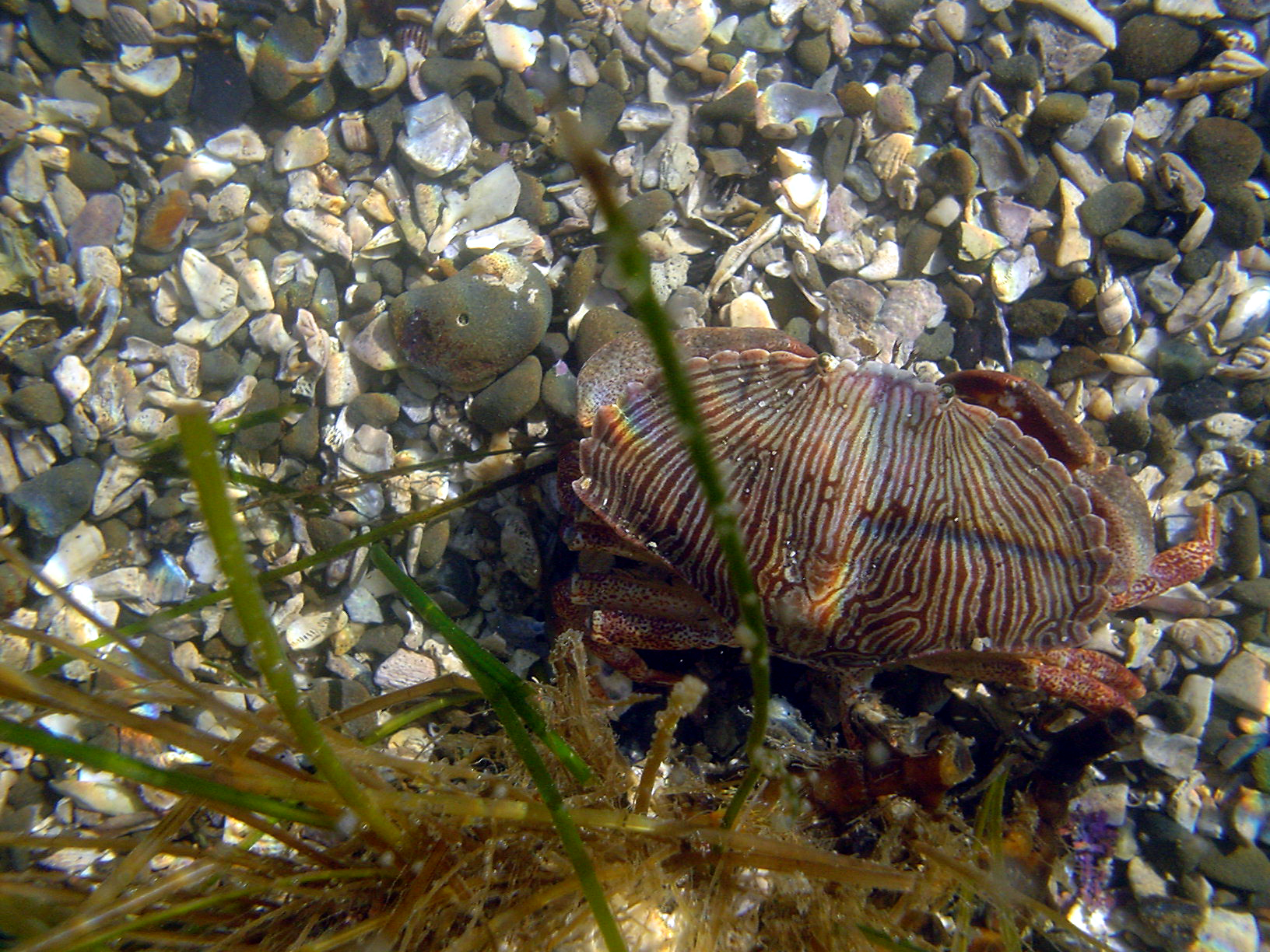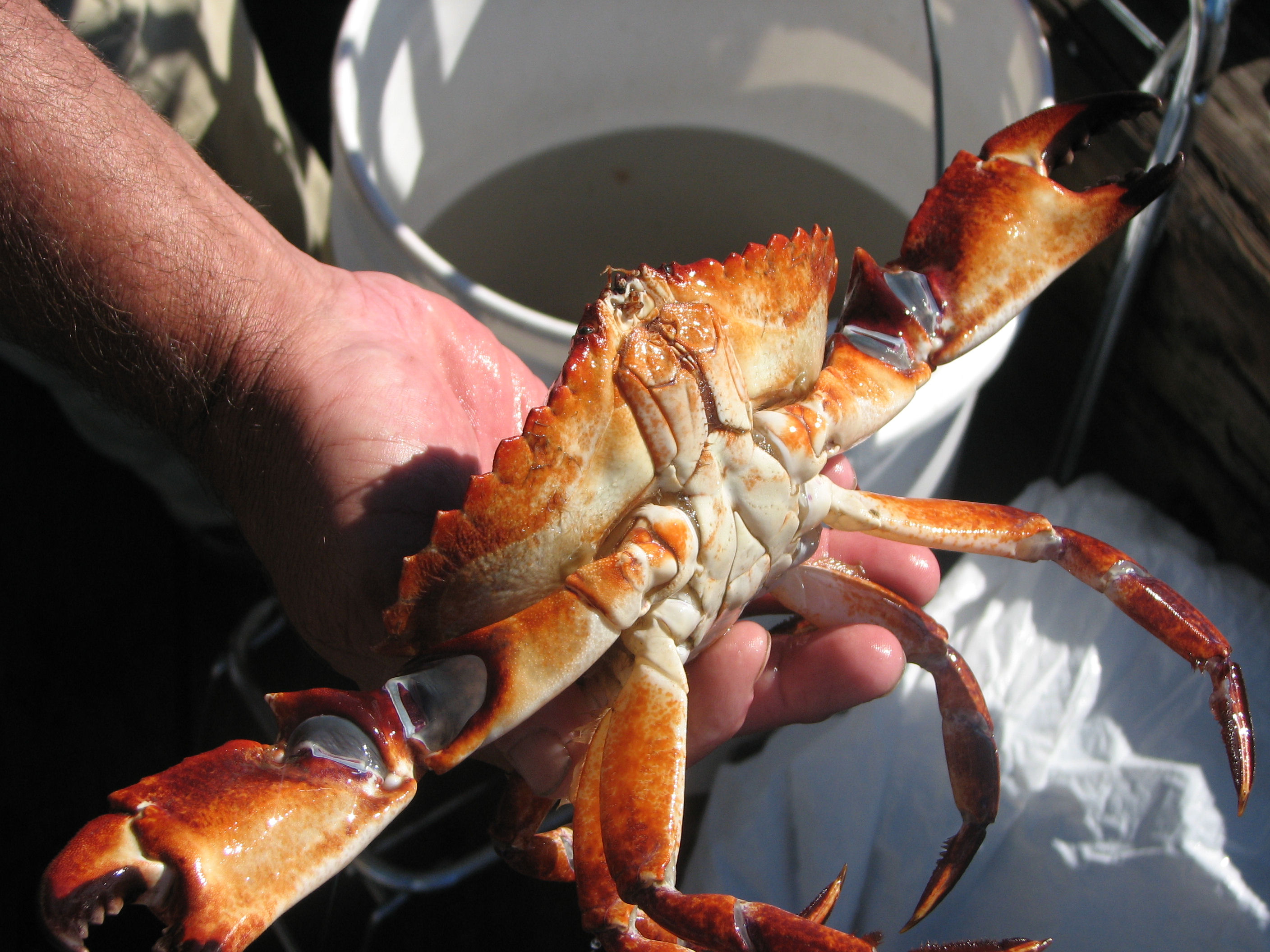Cancer Productus on:
[Wikipedia]
[Google]
[Amazon]
''Cancer productus'', one of several species known as red rock crabs, is a
 ''Cancer productus'' has
''Cancer productus'' has
 ''Cancer productus'' ranges from
''Cancer productus'' ranges from
Walla Walla University Marine Inverts Key: ''Cancer productus''
{{Taxonbar, from=Q5031457 Cancroidea Crustaceans of the eastern Pacific Ocean Crustaceans described in 1839 Fauna of the San Francisco Bay Area
crab
Crabs are decapod crustaceans of the infraorder Brachyura, which typically have a very short projecting "tail" (abdomen) ( el, βραχύς , translit=brachys = short, / = tail), usually hidden entirely under the thorax. They live in all the ...
of the genus ''Cancer
Cancer is a group of diseases involving abnormal cell growth with the potential to invade or spread to other parts of the body. These contrast with benign tumors, which do not spread. Possible signs and symptoms include a lump, abnormal b ...
'' found on the western coast of North America
North America is a continent in the Northern Hemisphere and almost entirely within the Western Hemisphere. It is bordered to the north by the Arctic Ocean, to the east by the Atlantic Ocean, to the southeast by South America and the Car ...
. This species is commonly nicknamed the Pearl of the Pacific Northwest
The Pacific Northwest (sometimes Cascadia, or simply abbreviated as PNW) is a geographic region in western North America bounded by its coastal waters of the Pacific Ocean to the west and, loosely, by the Rocky Mountains to the east. Though ...
.
Description
 ''Cancer productus'' has
''Cancer productus'' has carapace
A carapace is a Dorsum (biology), dorsal (upper) section of the exoskeleton or shell in a number of animal groups, including arthropods, such as crustaceans and arachnids, as well as vertebrates, such as turtles and tortoises. In turtles and tor ...
teeth that are somewhat broad and rounded with teeth between the eyes of nearly equal size and shape. The carapace of ''C. productus'' is widest at the posterior-most tooth, up to 20.0 cm wide. The pincers are large with distinctive black tips. This species lacks serrations or projections on the ventral side of the claws. Adults have a brick-red coloration throughout. The coloration of juveniles is diverse, often white, sometimes with red spots, or zebra-striped.
Similar species
Dungeness crab
The Dungeness crab (''Metacarcinus magister'') is a species of crab inhabiting eelgrass beds and water bottoms along the west coast of North America. It typically grows to across the carapace and is a popular seafood. Its common name comes from ...
(''Metacarcinus magister'') has serrations on the dorsal side of the cheliped
A chela ()also called a claw, nipper, or pinceris a pincer-like organ at the end of certain limbs of some arthropods. The name comes from Ancient Greek , through New Latin '. The plural form is chelae. Legs bearing a chela are called chelipeds. ...
s and lacks black tips. The graceful rock crab (''Metacarcinus gracilis
The graceful rock crab or slender crab, ''Metacarcinus gracilis'' (the naming convention recognized by WoRMS) or ''Cancer gracilis'' (the naming convention recognized by ITIS), is one of only two members of the genus '' Metacarcinus,'' recognized ...
'') has a single projection on the dorsal side of the chelipeds and also lacks black tips, and the widest point of carapace is at the second posterior-most tooth. The pygmy rock crab ('' Glebocarcinus oregonensis'') has black-tipped chelipeds, but has large tubercle
In anatomy, a tubercle (literally 'small tuber', Latin for 'lump') is any round nodule, small eminence, or warty outgrowth found on external or internal organs of a plant or an animal.
In plants
A tubercle is generally a wart-like projection ...
s on the dorsum. ''Glebocarcinus oregonensis'' is also much smaller, such that a ''C. productus'' of similar size would generally have a striking juvenile coloration. Cancer pagurus
''Cancer pagurus'', commonly known as the edible crab or brown crab, is a species of crab found in the North Sea, North Atlantic Ocean, and perhaps the Mediterranean Sea. It is a robust crab of a reddish-brown colour, having an oval carapace with ...
is very similar, but distinguished by its non-overlapping range.
Range and habitat
 ''Cancer productus'' ranges from
''Cancer productus'' ranges from Kodiak Island
Kodiak Island (Alutiiq: ''Qikertaq''), is a large island on the south coast of the U.S. state of Alaska, separated from the Alaska mainland by the Shelikof Strait. The largest island in the Kodiak Archipelago, Kodiak Island is the second larges ...
, Alaska
Alaska ( ; russian: Аляска, Alyaska; ale, Alax̂sxax̂; ; ems, Alas'kaaq; Yup'ik: ''Alaskaq''; tli, Anáaski) is a state located in the Western United States on the northwest extremity of North America. A semi-exclave of the U.S., ...
, to Isla San Martine, Baja California
Baja California (; 'Lower California'), officially the Free and Sovereign State of Baja California ( es, Estado Libre y Soberano de Baja California), is a state in Mexico. It is the northernmost and westernmost of the 32 federal entities of Mex ...
. It inhabits mid-intertidal
The intertidal zone, also known as the foreshore, is the area above water level at low tide and underwater at high tide (in other words, the area within the tidal range). This area can include several types of Marine habitat, habitats with var ...
waters to 79 m depth.
Biology
''Cancer productus'' iscarnivorous
A carnivore , or meat-eater (Latin, ''caro'', genitive ''carnis'', meaning meat or "flesh" and ''vorare'' meaning "to devour"), is an animal or plant whose food and energy requirements derive from animal tissues (mainly muscle, fat and other sof ...
; in Puget Sound
Puget Sound ( ) is a sound of the Pacific Northwest, an inlet of the Pacific Ocean, and part of the Salish Sea. It is located along the northwestern coast of the U.S. state of Washington. It is a complex estuarine system of interconnected ma ...
it will crush barnacle
A barnacle is a type of arthropod constituting the subclass Cirripedia in the subphylum Crustacea, and is hence related to crabs and lobsters. Barnacles are exclusively marine, and tend to live in shallow and tidal waters, typically in eros ...
s with its large pincers for consumption. Small living crabs and dead fish
Fish are aquatic, craniate, gill-bearing animals that lack limbs with digits. Included in this definition are the living hagfish, lampreys, and cartilaginous and bony fish as well as various extinct related groups. Approximately 95% of li ...
are also eaten. Mating in this species occurs when the female is soft-shelled from October to June in Puget Sound. The male can often been seen guarding females until molting during this time. This species is known to be a favorite prey item of the giant Pacific octopus, ''Enteroctopus dofleini
The giant Pacific octopus (''Enteroctopus dofleini''), also known as the North Pacific giant octopus, is a large marine cephalopod belonging to the genus ''Enteroctopus''. Its spatial distribution includes the coastal North Pacific, along Mexico ...
''.
Fishery
''Cancer productus'' is harvested by sport and commercial fishermen in California, mostly fromMorro Bay
Morro Bay (''Morro'', Spanish for "Hill") is a seaside city in San Luis Obispo County, California. Located on the Central Coast of California, the city population was 10,757 as of the 2020 census, up from 10,234 at the 2010 census. The town ...
south. The California rock crab fishery is made up of three species – the yellow rock crab ('' C. anthonyi''), the brown rock crab ('' R. antennarium''), and the red rock crab (''C. productus''). Rock crab landings for 1999 were 790,000 pounds and have averaged 1.2 million pounds per year from 1991–1999.
It is not as sought after as Dungeness crab
The Dungeness crab (''Metacarcinus magister'') is a species of crab inhabiting eelgrass beds and water bottoms along the west coast of North America. It typically grows to across the carapace and is a popular seafood. Its common name comes from ...
due to the considerably lower amount of flesh. However, the flesh has a delicate flavor and slightly sweet taste. The similar ''Cancer pagurus
''Cancer pagurus'', commonly known as the edible crab or brown crab, is a species of crab found in the North Sea, North Atlantic Ocean, and perhaps the Mediterranean Sea. It is a robust crab of a reddish-brown colour, having an oval carapace with ...
'' has a major commercial fishery in western Europe. Both males and females with a carapace exceeding may be harvested in Washington
Washington commonly refers to:
* Washington (state), United States
* Washington, D.C., the capital of the United States
** A metonym for the federal government of the United States
** Washington metropolitan area, the metropolitan area centered o ...
, when in season.
References
External links
*Walla Walla University Marine Inverts Key: ''Cancer productus''
{{Taxonbar, from=Q5031457 Cancroidea Crustaceans of the eastern Pacific Ocean Crustaceans described in 1839 Fauna of the San Francisco Bay Area